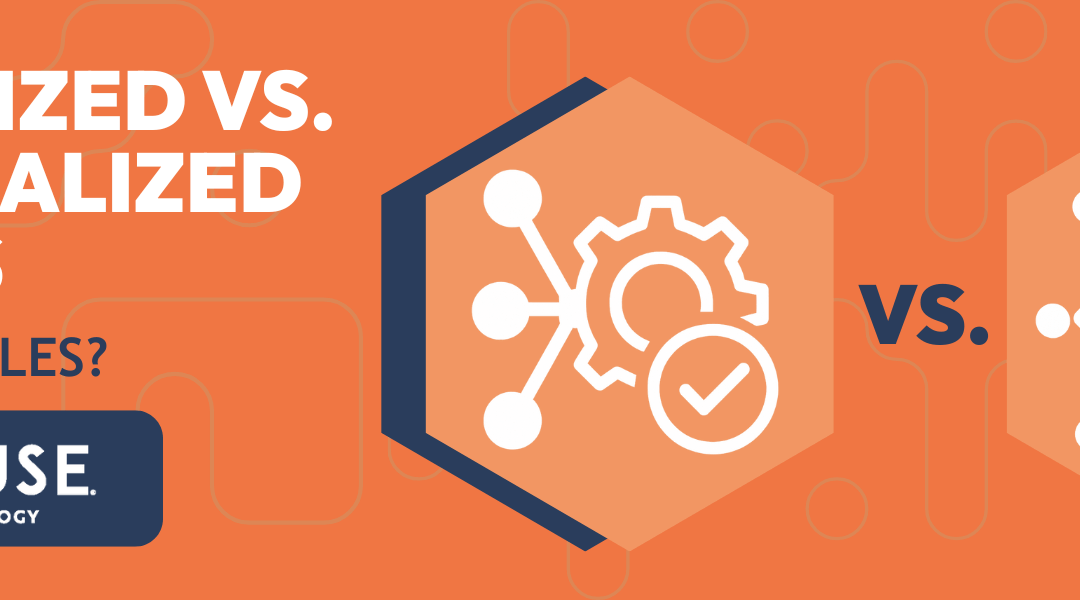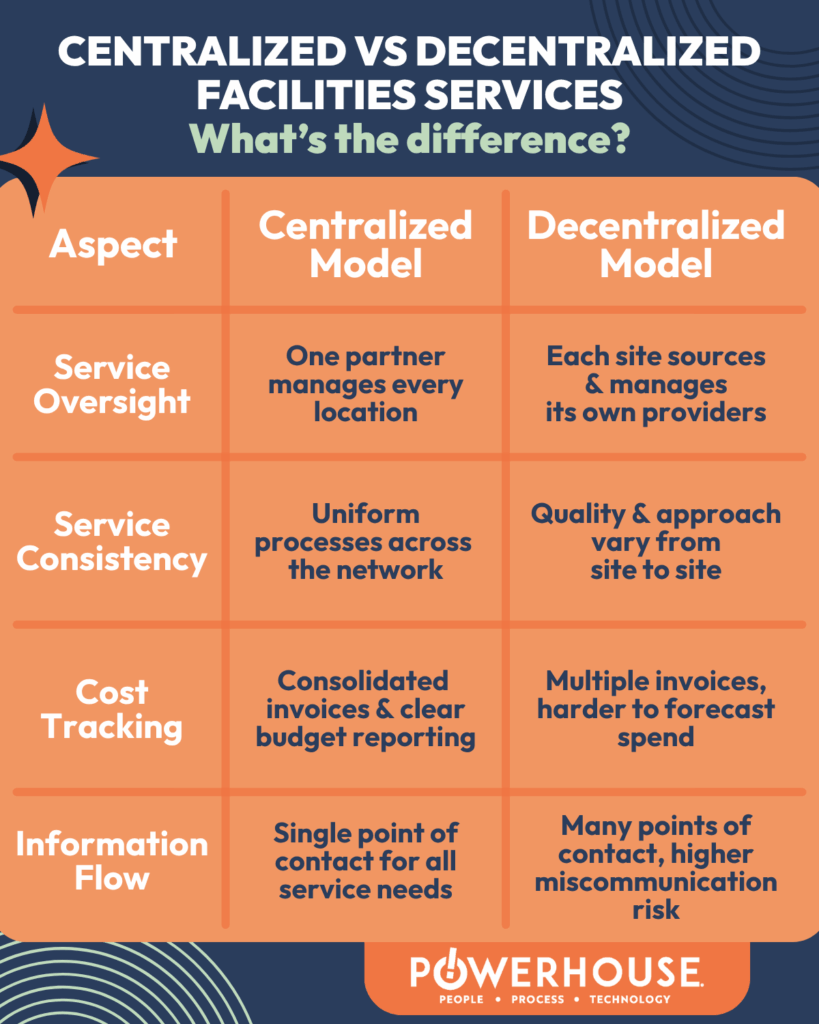Managing one facility has its challenges. Managing dozens (or hundreds) of locations can feel like a never-ending game of catch-up.
Service requests stack up. Contractors miss the mark. Invoices flood in from every direction. And when every site handles things on their own, operations slip from “manageable” to mayhem.
Choosing between a centralized and decentralized service model isn’t just an operational decision – it’s a strategic one. The right setup brings clarity, consistency, and control. The wrong one? It leads to confusion, wasted time, and a whole lot of easily avoidable headaches.
This article breaks down both models, highlights where each one works (and where it doesn’t), and helps you decide which path will ultimately keep your operations running smoothly at every scale.
Centralized vs Decentralized Maintenance Services – What’s the Difference?
When we talk about centralized vs. decentralized service models, it’s a question of structure: unified and consistent, or fragmented and variable?
- Centralized model – one partner handles all your services across every site. It’s one point of contact, one process, and one consistent standard across the board.
- Decentralized model – each site manages its own services independently. Different vendors, different expectations, different results.
Here’s a side-by-side look of what that means in practice:
Behind the Scenes: How Your Service Model Affects the Day-to-Day
Speed & Scalability
When you’re rolling out services across multiple locations, speed is crucial. So is a game plan that supports scale.
Thats where centralized models shine. With one provider handling logistics, scheduling, and execution, you can move faster – perfect for time-sensitive programs like national refreshes, seasonal preps, or large-scale brand rollouts. You skip the lag that comes with chasing dozens of vendors across all your markets.
- Quicker rollout timelines for initiatives that can’t wait.
- Standardized processes that eliminate confusion across locations.
- Reliable scheduling that keeps every site on track, regardless of geography.
Decentralized models can offer more local flexibility, but they tend to slow things down when volume ramps up. Every site works differently, creating bottlenecks, duplicated efforts, missed milestones, and inconsistent execution.
Quality & Consistency
Different providers deliver different outcomes. And when every site handles things in their own way, maintaining brand continuity becomes nearly impossible.
A centralized model helps lock in consistent expectations, quality checks, and performance benchmarks across your footprint. Centralized service models not only reduce operating costs – they also improve consistency by standardizing protocols across locations. Every technician, service call, and report follows the same playbook set by you and your team. That means fewer surprises and more confidence in the outcome.
- Uniform service protocols that align with your brand’s expectations.
- Centralized oversight to ensure work is completed correctly, not just quickly.
- Repeatable quality that builds trust with stakeholders and tenants.
Decentralized models often depend on what’s available locally. Some vendors will deliver. Others? Not so much. The result is a patchwork of outcomes – and more time spent fixing what should’ve been right the first time.
Billing, Accountability, & Communication
Buried under paperwork and follow-ups? Managing multiple vendors across different markets means more than just different faces – it means different invoices, contacts, timelines, and expectations. It’s a recipe for confusion and wasted time.
Experts across the industry agree: when services are centralized, operations run smoother, and teams spend less time untangling avoidable issues.
That’s exactly what centralized service delivery solves. With one partner, like Powerhouse, handling everything, you get:
- Consolidated billing that simplifies budgets and reduces invoice overload.
- One point of contact for questions, updates, and issue resolution.
- Simplified service tracking across your entire portfolio – without chasing down paperwork.
Running everything through one system gives you real control. No more chasing updates – you’re staying ahead of problems. Issues get addressed faster, service histories are documented, and expectations are clear from day one.
Decentralized setups can still be effective – but they often require much more oversight, follow-up, and tolerance for variability.
Transparency & Technology
The larger your footprint, the harder it gets to keep tabs on what’s happening at every site. And when updates live in scattered records across multiple systems, it’s easy for things to slip through the cracks.
That’s where centralized platforms make a difference.
At Powerhouse, our proprietary platform, MetryX, gives clients a single source of truth – from real-time job updates to full-service histories delivered instantly, right from your dashboard. Whether you’re overseeing a multi-site refresh or monitoring daily reactive work, MetryX brings clarity to the entire process.
- Live project tracking so you’re never left wondering what’s happening.
- Digital documentation of work orders, approvals, and on-site activity.
- Built-in reporting tools that surface trends and support smarter planning.
As centralized technology becomes more essential, industry experts note that smart platforms and CMMS tools are now critical to reducing downtime and boosting asset longevity through real-time insight – closing what they call a growing “visibility gap.”
In decentralized setups, critical data lives in multiple places – one vendor portal here, another spreadsheet there – making real-time job tracking nearly impossible.
Scattered systems can’t offer this level of clarity. When tech powers your service model, you get more than updates – you get confidence in what’s happening at every level, across all your locations.
Which Model Is Right for Your Needs?
There’s no one-size-fits-all answer, just the right fit for your organizational needs.
Some teams need tight coordination across all locations. Others want flexibility to make site-level decisions based on specific needs. The right model depends on your priorities: speed, control, consistency, flexibility, or a combination of them all.
Here’s a quick breakdown of where each model tends to make the most sense:
A centralized model is often the better choice for:
- Multi-site brands looking to streamline operations
- High-volume programs like national rollouts or refreshes
- Sectors with strict compliance, reporting, or brand consistency standards
A decentralized model works better for:
- One-off projects, low-volume, or limited-scope initiatives
- Unique locations with highly specialized service needs
- Organizations that already have established local vendor relationships
As your operation grows, the cracks in a disjointed approach start to show. Without structure and consistency, small issues accelerate into big ones fast – and the cost of staying reactive adds up.
So, ask yourself: Do you want to spend your time managing a hundred moving parts – or partner with someone who brings it all together into one unified process and takes the weight off your shoulders, so you can focus on what matters most?
From Complexity to Control
Your service model should simplify – not complicate – your operations. The right model should remove friction, not flexibility. It should give you more control with less effort, not add layers of complication.
When every site runs through a single, structured system, you don’t just gain oversight – you gain control. Powerhouse helps national brands reduce complexity and elevate quality with structured, scalable, tech-powered solutions.
If you’re managing multiple sites, it might be time to simplify how you manage your services. Let’s talk about how Powerhouse helps brands reduce complexity – while raising the service bar.


